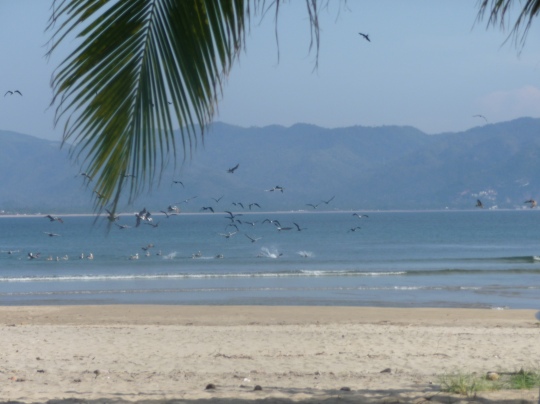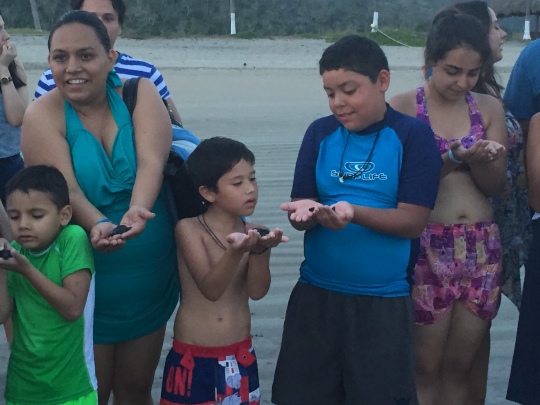
Playa Tenecatita With Brown Pelicans and Magnificent Frigatebirds
In December 2016 Nikk and I again sailed south about 120 miles to Tenecatita, a lovely bay and anchorage where many cruisers gather in winter. In the previous two blogs there are numerous details of the adventures awaiting the cruisers and shore folk who visit this area.
After anchoring Balance in a protected little corner of the bay with about six other boats, we paddled our kayaks to shore, and gratefully landed with no mayhem. While Nikk played bocce ball on the beach I walked down to the Blue Bay Hotel area with several of the women and went to investigate the Turtle Sanctuary. There in a concrete holding tank were 23 baby turtles, just hatched from their eggs, some with the membrane still attached, awaiting their release to the ocean, which we were told would occur at 6 pm that night. With excitement I hurried back to tell Nikk and we agreed to stay on shore and wait the three hours until release time.

These are probably Olive Ridley sea turtles
Mexico has six of the seven endangered species of turtles, and Mexico is at the forefront of turtle conservation. This is just in time, because turtle meat and turtle eggs have been a source of food and income for centuries in Mexico. When the military was occupied in Chiapas with the rebels some years ago, hundreds of thousands of turtle eggs were looted from beaches that had formerly been protected by the military. Now the government is promoting agroforestry and chicken farms to provide eggs to replace the need for turtles.
Turtles come back to the beach where they were hatched years before to lay their eggs, after swimming thousands of miles to feed and then mate. In that time they face predators, including humans, and being trapped as a byproduct of fishing boats with huge nets. I read that recently many of the huge fishing boats have started using nets which release turtles and dolphins. Still, of 1000 baby turtles that manage to make it to the ocean, only 1-3 are estimated to return to their beach to lay eggs. In the Marina Riviera Nayarit in La Cruz, I have seen several large adult Green Turtles swimming inside the marina, looking for the beach that was there before the marina was begun in 2006. I don’t know what they can do when they can’t find their beach.
Playa Tenecatita at the Blue Bay Hotel is one of several turtle conservation beaches along the Costalegre, the area of beaches in the state of Jalisco stretching from Puerto Vallarta to Tenecatita, and then to Manzanillo in Colima state. Four of the six species in Mexico are found here. We often see huge turtles swimming along while we sail, sometimes we even see them mating. The turtle conservators, who are paid by the Mexican government, collect the eggs (up to 200!) when they are laid and place them in the sand inside a pen that is guarded 24 hours a day. A sign is erected and placed above the buried eggs, giving date of laying, number of eggs, and then later the date of hatching and how many baby turtles are successfully hatched. The actual hatching is called a “frenzy”, which makes me suspect that the turtles hatch all at once from their clutch.

The sign says that there are 60 nidos (nests) and 113 eggs?

Los Angeles Locos is the local turtle protection group
At 6 pm many people, young and old, gathered in excited groups at the concrete pen containing the baby turtles. Luckily for us some of the people were vacationing from the U.S., spoke both English and Spanish, and were happy to translate the instructions and information.

Two guards gathered the turtles into buckets and began to walk to the water’s edge with the humans following, eagerly awaiting what we assumed would be the guards releasing the turtles near the surf.

When we arrived at the edge of the beach we were very surprised to have the guards line us up in an open rectangle and begin giving us the baby turtles to hold. The baby turtles flailed their flippers vigorously, making them hard to keep aloft.


Seeing the looks of rapt attention and the care that the children showed for the baby turtles gave me an upwelling of grateful emotions.

The turtles felt cool and their shells were hard.
Soon it was time to lower the turtles carefully onto the sand, and they scrabbled themselves slowly towards the surf. There was a lot of cheering from the sidelines as one by one the baby turtles met the waves and were carried out into the bay. Sometimes it took several waves before one big enough to carry the turtle away arrived. The turtles were released at sunset when the pelicans and other birds were back at their nightly roosts, to avoid the pelicans snacking on the baby turtles like they do in Puerto Vallarta when the release takes place in the late afternoon.



“Goodbye little turtle”, we said, “live long and prosper on your journeys far and wide”.
With happy hearts we walked back down the beach to the kayaks, being grateful to all the caring Mexicans who help restore and conserve the turtle populations of the Costalegre, including all the people who came to the beach to participate. The joy in our hearts was echoed by the warmth of the deep red sunset.

Several sites with information about participating in turtle rescue are here:
https://www.mexperience.com/outdoors
http://www.puertovallartatours.net/baby-sea-turtles
Comments on: "Tortugas Bebes de Tenecatita(Baby Turtles of Tenecatita)" (2)
Wow! so jealous! Looks like a great time.
Thank you for this beautiful post. Warmed my heart.